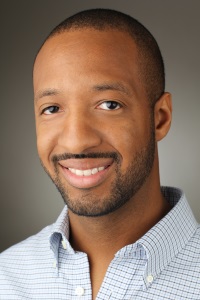2018 School Spending Survey Report
Five questions for Varian Johnson
Varian Johnson (who was co-valedictorian, with his twin brother, of his high school class, thank you very much) enjoys two careers: as an author and an engineer.
 Photo: Kenneth B. Gall
Photo: Kenneth B. GallVarian Johnson (who was co-valedictorian, with his twin brother, of his high school class, thank you very much) enjoys two careers: as an author and an engineer. It's not surprising, then, that his new book The Great Greene Heist (Scholastic, 12–16 years) is so meticulously — almost mathematically — plotted. But it's not all by-the-numbers, not by a long shot. Johnson cites the Ocean's Eleven films and the movie Sneakers, along with The Westing Game, as inspirations for his hugely entertaining (and refreshingly diverse) caper about middle-school con-man-with-a-heart-of-gold Jackson Greene, election tampering, and getting the girl — that is, if she doesn't get you first.
1. Are you more of a Jackson Greene or a Charlie de la Cruz? (Or, god forbid, a Keith Sinclair?)
VJ: As much as I wish I were a Jackson Greene, I'm probably more like Charlie. I'm a twin, and my brother was president of most of the high school and college organizations we were involved in. I was more likely to be treasurer or another role not in the spotlight. I always fancied myself as the guy behind the scenes making it all happen — turning someone's vision into reality. Plus, I was never as cool as Jackson. (But neither was my brother.)
2. George Clooney or Frank Sinatra? Or, heck, Robert Redford? ("My name is my password…")
VJ: Oh, I love Robert Redford! Sneakers combines everything I adore about heist movies — techy, nerdy outcasts; twisted plots; a mix of high-tech and low-tech solutions; and a touch of romance. Robert Redford somehow pulled off the right balance of sophistication and dishevelment. Plus, James Horner and Branford Marsalis collaborated on a killer soundtrack. All that is a hard combination to beat.
 3. How on earth did you keep all those cons straight? And have them fit so perfectly together? Can we see your spreadsheet?
3. How on earth did you keep all those cons straight? And have them fit so perfectly together? Can we see your spreadsheet?VJ: Keeping the cons straight took a lot of time and energy. I didn't maintain a spreadsheet; instead I kept a huge text file that outlined all of the cons and characters, along with a calendar that marked when each person or object of interest was introduced. I used Scrivener to write the novel, which allowed me to easily group scenes by day, color-code the points of view of each scene, and tweak the chronology.
The ending was the hardest part to write. Similar to Ocean's Eleven, I wanted the grand finale to occur over a short amount of time, with everyone in the same location. I finally came up with the idea of the Fall Formal, which in turn fueled Jackson and Gaby's story. It was very much a cyclical process.
4. Were you one of those kids who figured out the solution to The Westing Game? Is that how your brain works?
VJ: I first read The Westing Game when I was very young, and I can't remember if I figured out the solution then. What really stuck with me was Turtle Wexler and two of her more memorable traits — her long braid and her habit of kicking people in the shins. When I came up with Jackson Greene, I wanted him to have a few "trademarks" as well, which led to his tie (skewed slightly to the left) and notebook.
In general, I love puzzles. I'm a civil engineer, and for the first ten years of my career I designed bridges. Everything we designed was a puzzle: how to fit the safest structure into the smallest footprint with the least cost in the fastest time. I think my brain has always been wired like that.
5. How did you get your characters' voices just right? Do you spend a lot of time around teenagers?
VJ: I don't spend as much time around teens as I used to. As far as getting the voices right, I just tried to make the characters as believable and distinct as possible. It helped that some of them are tech geeks — that apple didn't fall far from the tree.
From the July 2014 issue of Notes from the Horn Book.
![]()
RELATED
RECOMMENDED
ALREADY A SUBSCRIBER? LOG IN
We are currently offering this content for free. Sign up now to activate your personal profile, where you can save articles for future viewing.







Add Comment :-
Comment Policy:
Comment should not be empty !!!
Carol Brendler
I just finished The Great Greene Heist. It keeps you guessing right down to the last page, and that's as hard for a novelist to pull off as it would be to pull off the actual heist!Posted : Jul 10, 2014 02:35
Sheila Welch
Thanks for this interview. Varian's book sounds perfect for middle -school age kids. I'm buying a copy for my grandson, and I'll also suggest it to the librarian at the public library. I found it interesting that Varian sees how plotting a novel is similar to solving a puzzle or designing bridges. Others with a musical background or talent might think of writing a novel as a lot like composing a symphony. My background is in fine arts, and I feel that writing a novel is much like creating a painting with the plot being contained by the edges but with movement and meaning.Posted : Jul 10, 2014 04:12
Donna Gephart
Elissa, thank you for the great interview. I can't wait to read THE GREAT GREENE HEIST. Wishing a world of success for Varian!Posted : Jul 09, 2014 04:44